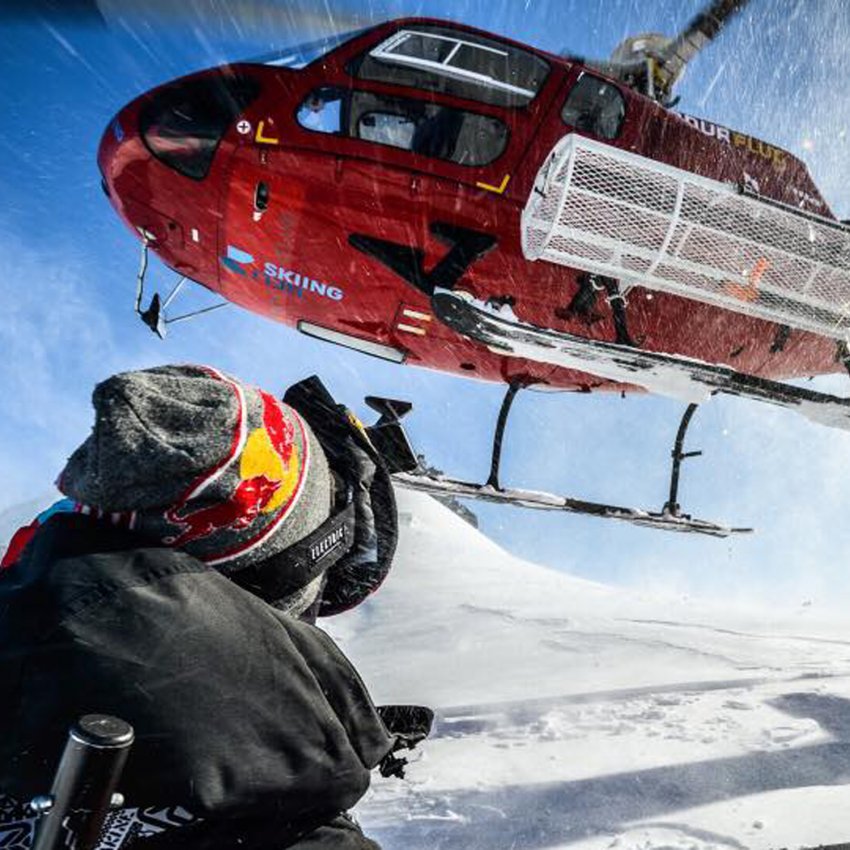A new booking platform, Heli, aims to make adventure sports more accessible to the masses by linking operators in one hub.

Heli’s chief executive officer and founder, Andy Culp. Photographer: Alain Sleigher(.com).
Earlier this month at the Manhattan launch party for Heli, a new website for booking adventure sports, the crowd in attendance had ballooned beyond expectations and seemed to include a fair number of heli-skiing newbies.
Brandon Darnton, 32, the company’s director of partnerships and employee number 2, was manning the check-in desk. He looked around the gathering of young men in flat-brimmed hats and office-casual Oxfords and observed: “We’re going to need a bigger venue next year.”
Heli-skiing is not everyone’s idea of fun—getting airlifted to remote mountain peaks to spend the day sluicing down untracked powder without another skier, or anything like a trail, in sight. Beyond the money to pay for it and the vacation days to enjoy it, the sport requires relatively high levels of skill, fitness, and risk tolerance, which means it appeals mostly to skiers at the high end of the passion spectrum rather than the average resort goer. But Heli’s founders are betting that there are more potential heli-skiers out there and that by making this niche hobby a bit more accessible, they might just be able to find them.
Heli’s idea is simple, but novel for heli-skiing: it aims to demystify and streamline the sport by creating an online marketplace for booking trips. It’s aimed at a younger, more spontaneous, and more tech savvy demographic than the typical heli-skiing client. The driving forces behind Heli—Andy Culp, 32, the founder and chief executive officer, and co-founder Brock Strasbourger, 30, who’s focused on digital strategy and product development—are in that younger target audience themselves. Culp ski-bummed in Vail and worked as a sales rep with CMH, the first, and biggest, heli-skiing operation in the world. He met Strasbourger, an Aspen native who has worked in product development for e-commerce startups, in late 2014. The pair quickly bonded over their interest in skiing, among other things, and by fall 2015 had formalized Heli as a partnership. They knew the small industry well enough to know where it failed—in bringing in fresh fans and keeping them engaged.

“We bring operators a new clientele,” Culp told me, “in an age group that won’t necessarily call a 1-800 number.” The crowd at the Crosby Hotel that Thursday skewed male and mostly under 35 and looked to be about equal parts finance (chinos), tech (hoodies), and ski-industry affiliated (logo baseball caps). It’s exactly the group that the founders are aiming for.
How Heli Works
The website—or platform, as they’d call it—that they’ve spent the past year and a half building resembles an adventure-themed Airbnb, where users can research and book trips seamlessly with a few clicks. Skiers can create social-media-style profiles, and there are tools for influencers and brands to market directly to the users. It aims to offer as much to entice operators as customers, with access to customer metrics and booking functionality that a small helicopter trip provider might be hard pressed to replicate on its own. “I’ve always hated when people say, ‘Oh, we have the Uber for whatever,’” Strasbourger told me, “but to make people understand, we’d say we’re basically going to build, on the consumer-facing side, a Kayak/Airbnb, on the social side like a Facebook-style feed, and on the outfitter side, like a Shopify for adventure travel.”
The launch doubled as the New York premiere of Drop Everything, this season’s new release from the ski film company Matchstick Productions. But before they could watch pro skiers dropping off cliffs and skiing extreme lines effortlessly, the crowd got the Heli pitch as Strasbourger and Culp took the stage.

“Heli’s mission,” Culp explained in a promotional video screened to the gathered crowd, is “to unite through adventure.” The short film featured gorgeous shots of skiing, but also kiteboarding, scuba diving, sailing, fishing, motocross, BASE jumping, and even swimming with dolphins. It spoke to Heli’s ambition to expand to as many adventure sports as can be helped by the technology.
Can they really pull it off? It’s a clichéd setup at this point: ambitious young friends plotting to leverage new technology and millennial marketing savvy to upend an industry they deem inefficient or antiquated—disruption personified. When I first met them a year ago, they had little more than a nicely curated, 20,000-follower Instagram feed and an idea, but they were ambitious, passionate, and engaging and believed so much in what they were doing that I decided it might be interesting to follow along on their journey.
“I think by next winter, we’ll have the tech platform built out,” Culp told me at the time. “By October or November 2017, we’ll be ready to go.”
Here we are, in October 2017, and the site is launched. But is the market ready for them?
The Heli-Skiing Puzzle
Heli-skiing has been around since the early 1960s, but it didn’t really start to take off until the 1990s. The past 10 years have seen continued growth and a number of new operators opening up shop , but it remains a small sport, with fewer than 60 operations in North America, and something like 100,000 skier days booked annually. It often costs more than $1,000 a day for a heli-ski trip, which typically includes a stay at a high-end lodge with restaurant-caliber dining, and as a result, operators report that roughly three-quarters of their bookings are from repeat clients. Either you can afford to be a regular, or it’s not for you.

For decades, many operators have utilized sales agents, specialized travel agents who book heli and other ski trips for multiple lodges and take a percentage for themselves. It was a system that worked well for a while, but increasingly there seems to be a need for some innovation on the sales and marketing side. “If you want to go heli-skiing, you can call up and talk to 20 different places, or you can go to their site and have it in one central place,” says pro-skier Julian Carr, one of the athletes who has been advising Heli as they’ve built out the platform. And he points out another issue facing the sport. “The older places can be kind of an old-boys club, and their repeat customers are aging.” That’s where Heli seems to have found an opening: If it can attract a fresh crop of younger clients, it would be invaluable to operators old and new.
But while most would agree that there’s an opportunity for innovation in how heli-skiing is marketed, there’s some “wait and see” skepticism in the industry, with some seeing this as an old idea dressed up in a new, tech-savvy outfit. “The idea of a sales agent that sells an inventory of holidays across a number of different operators has been in place for 20 or 30 years,” says Ian Tomm, Executive Director of HeliCat, the trade association for Canadian heli- and cat-skiing operators. He thinks Heli could potentially help drive new skiers, but there are limits. “We’re a pretty small industry at the end of the day, with pretty small margins.”
“This concept of third-party middlemen for heli has been around a long time, but there’s just not a lot of money in it. Most don’t last more than a year or two—a lot of them just seem to fizzle out,” says Scott Raynor, owner and guide at Valdez Heli-Ski Guides and Vice President of HeliSkiUS, an industry group for US heli operators. He also points out that heli-skiing isn’t a one-size-fits-all experience, which could pose problems for automated booking. “For us in Alaska, it requires a higher level, more prepared skier, so there’s also the issue of making sure we’re getting the right kind of client with the right expectations.”
Starting With Social
Last winter, using a growing e-mail list and their Instagram feed, which had amassed roughly 40,000 followers by that point, Heli’s founders partnered with 18 operators and began booking trips. They were effectively operating as sales agents while building up their relationships and promoting custom experiences, such as a New Year’s bash at Northern Escape co-sponsored with Unofficial Networks, a ski blog with great reach among the millennial skier set. That trip and others sold out quickly, which seemed to validate their core premise—that there was a need for something like this in the market.
One operator that came on board early in the process is Silvertip Lodge & Heliskiing, in Quesnel Lake, British Columbia, which is only in its second full season of operations. “We’re a fairly new operation, so we really need keen sales folks like them,” said Isabelle Thibeault, head of Silvertip’s sales and marketing, who connected with Heli last winter. “They understand the market really well, and they understand the image we’re trying to put out there, so they sell it better than most. And they’re targeting the younger generation, which is increasingly important.”
They have a good sense of what trip providers need, too. Whereas traditional booking agents with smaller client lists have usually worked with just a handful of operators and focused on bookings made well in advance of the season, Heli is able to work with as many operators as sign up, putting all the information in one spot while allowing for far greater flexibility and spontaneity. Operators looking to fill a few empty seats or add a new trip to take advantage of late season snow can push those out on the Heli site with discounts or as part of special packages. And the platform Heli has built offers them access to all sorts of data and functionality. “It’s incredibly useful, having access to all that information,” said Thibeault. “If you put up two or three trip offers, you can see what people are coming back to look at, what they are booking, what they saved.”
Heli is also building custom trips around pro athletes whom Culp calls “ambassadors.” Carr, the pro-skier, is one such ambassador, and like many athletes in his position, he has a large social media following but limited ways to monetize it. Athletes can partner with Heli to help promote trips to their fans, receiving a cut of any bookings they generate and multiplying Heli’s marketing reach in the process.
A Million Dollars in Bookings
Over their first 18 months of existence, without a proprietary platform, they sold more than $1 million in trips, and though it’s early yet, they say they are on pace to do multiples of that this season with the launch of the site and their expansion into other areas.
The platform is fully functional, and customers are actively booking trips from a selection of 37 winter sports operators—primarily heli-skiing, but also cat-skiing and ski touring—around the world. They have 10 athletes signed up as ambassadors, a 50,000-person email list to go with their now-55,000 Instagram followers, and they are are aggressively expanding into kiteboarding and surfing. Diving, fishing, and African safaris are hopefully next.
This winter will be the real test. The launch event proved the Heii team knows how to translate digital stoke into a good party—after the film, the founders raffled off skis and other gear, and tossed black t-shirts emblazoned with the Heli logo into the crowd. But there’s a difference between clicking to buy a $20 ticket to a ski film and clicking again to book a ski trip for many thousands of dollars. The founders are, of course, optimistic. At the end of the launch party, as Culp and Strasbourger headed off for some late night food and I headed home to bed, they stopped to chat with a group of guys in the street, wearing their new Heli T-shirts.








